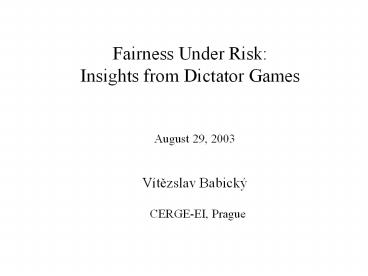CERGE-EI, Prague - PowerPoint PPT Presentation
Title:
CERGE-EI, Prague
Description:
Dictator giving p is higher for lower variance treatments if r 0, ... but different variance (note: symmetric ... For group A (low variance, 13 subjects) ... – PowerPoint PPT presentation
Number of Views:53
Avg rating:3.0/5.0
Title: CERGE-EI, Prague
1
CERGE-EI, Prague
Fairness Under Risk Insights from Dictator Games
August 29, 2003
- Vítezslav Babický
2
- MOTIVATION
- Existing theories and experiments decisions
about ex-ante known pies, possibly with
information constraint. - Peoples life circumstances are diverse and
subject to chance events (even after decisions
made shares are distributed, prenuptial
agreement is signed) - So, lets introduce risk into decision making
process - (and lets stick to use of the expected utility
theory first)
3
VARIATION ON DICTATOR GAME The dictator game is
the simplest one the decision is affected only
by preferences of the decision-maker we can
study a single agents preferences
separately RISK Only a probability distribution
of the pie size is known to the dictator at the
moment of decision. The decision is to give a
percentage share of the actual pie to the
recipient.
4
Theory of fairness, competition and cooperation
FCC (Fehr, Schmidt, 1999)
- Proposed model aversion to differences in
payoffs - Utility function in the form
- Ui(x) xi (?i/(n1))?kmax(xixk,0)
- (?i/(n1))?kmax(xkxi,0)
- nnumber of players (2 for the dictator game)
- Empirical results for various classes of games
can be explained in accordance with this fairness
model
5
Theory of Equity, Reciprocity and Competition
ERC (Bolton, Ockenfels, 2000) Agents maximize
Vi Vi(yi, ?i) where yi is their payoff and ?i
?i(yi, c, n) is the relative payoff (c ?yi
total payoff) ?i yi/c if c gt 0 and 1/n
otherwise Under this utility function agents
have narrow self-interest assumptions Vi1 ? 0,
Vi11 ? 0, Vi22 lt 0, Vi2 0 for ?i 1/n
6
Examples Vi(c?i, ?i) aic?i bi/2(?i 0.5)2
ai, bi gt0 given constants Additively separable
Vi(yi, ?i) u(yi) v(?i) u concave, v convex
given functions Works for Dictator game (and
many others) Also works under incomplete
information Response to proposal in the
ultimatum game is done without knowing actual
size of the pie
7
THEORY MODIFICATIONS Need Utility concave For
the FS model, I can introduce exponent ?gt1 and a
concave function u into (note higher share is
always preferred to lower share by dictator, i.e.
xdictatorxrecipient always holds) Ui(x) u(xi)
?i (xi-xk)g Let C be random variable for the
size of pie and p be the decision of the dictator
the share on the pie transferred to the
recipient
8
The dictator solves maxp Eu((1p)C) ?
E((12p)C)g F.O.C. dEu((1p)C))/dp2??(12p)g-1
E(Cg)0 S.O.C. valid whenever u is concave For
simplicity, let u(x)sgn(r) xr , rlt1, r?0 be an
increasing concave CRRA function
9
The solution (12p)g-1(1p)1-r
r.sgn(r)E(Cr)/(2??E(Cg)) Left-hand side is
always decreasing in p (?gt1, rlt1), i.e. the
dictator giving is higher if the right-hand side
is lower (the decision depends on parameters ?,
r) If EC1EC2 then E(Ci2) determines variance of
Ci (since Var Ci E(Ci2) E(Ci)2) Obviously,
Var C1lt Var C2 iff E(C12) lt E(C22). Typically,
also E(C1g) lt E(C2g) for any ?gt1 E(C1r) gt E(C2r)
for any r in (0,1) and E(C1r) lt E(C2r) for all
rlt0 (namely for symmetric distributions)
10
For the ERC model, I can go through a similar
analysis Note V(x, ?) sgn(r) xr k
(?i0.5)g sgn(r) xr k (2?i1)g/2g sgn(r)
xr k (?i?k)g Dictator maximizes EV(p)
sgn(r) (1p)r E(Cr) k(12p)g The solution
(12p)g-1(1p)1-r r.sgn(r)E(Cr)/(2k?)
11
Now, the comparative statics is more
obvious (reminder the left-hand side is
decreasing in p) Dictator giving p is higher for
lower variance treatments if rlt0, it goes in the
opposite direction if r in (0,1)
12
Remark r0 the corresponding CRRA function is
u(x)log x Then, the dictator maximizes expected
utility EV(p) log(1p) E(log C)
k(12p)g i.e. the solution does not depend on
changes in the size of pie to be distributed in
this situation.
13
PILOT EXPERIMENT Dictator game with ex-ante
unknown size of pie in two groups. Both have the
same expected size but different variance (note
symmetric distributions were used). Subjects
asked to decide both absolute and relative part
of the pie to transfer to the second player.
They are also asked about the preference of one
of the decisions.
14
THEORETICAL PREDICTION Dictator giving is (in
relative terms) higher under low variance
treatment for coefficients of relative risk
aversion below -1 Dictator giving is (in
relative terms) lower under low variance
treatment for coefficients of relative risk
aversion above -1 Dictator giving in relative
terms is the same no matter the risk for
risk-neutral agents and for agents with CRRA
equal to -1
15
MORE INTUITION Relative giving is preferred
over absolute giving (and totally selfish agents
are indifferent between both ways)
16
RESULTS (Prague) (25 subjects, CERGE 1st year
students) For group A (low variance, 13
subjects) 4 decisions for absolute offer (risk
captured by proposer) Average offers 2108
absolutely 28 relatively (2506 expected
value) For group B (high variance, 12
subjects) 1 decisions for absolute offer Average
offers 1425 absolutely 17 relatively (1533
expected value)
17
CONCLUSION
- Attitude to fairness is related with attitude to
risk - Theory suggests that changes in dictator giving
under risky conditions correspond with opposite
changes under increasing sure pie - The observations (the pilot experiment) suggest
that the coefficient of relative risk aversion is
below -1, on average.































